| ________________
CM . . .
. Volume XXIII Number 36. . . .May 26, 2017

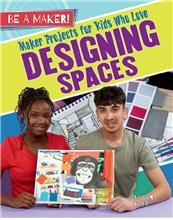 |
Maker Projects for Kids Who Love Designing Spaces. (Be a Maker!).
Megan Copp.
St. Catharines, ON: Crabtree, 2017.
32 pp., pbk., hc., & html, $9.95 (pbk.), $21.56 (RLB).
ISBN 978-0-7787-2580-0 (pbk.), ISBN 978-0-7787-2574-9 (RLB), ISBN 978-1-4271-1762-5 (html).
Subject Headings:
Interior design-Juvenile literature.
Handicraft-Juvenile literature.
Grades 5-7 / Ages 10-12.
Review by Gail Hamilton.
** /4
|
| |
|
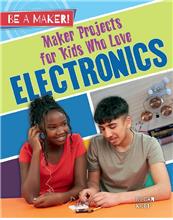 |
Maker Projects for Kids Who Love Electronics. (Be a Maker!).
Megan Copp.
St. Catharines, ON: Crabtree, 2017.
32 pp., pbk., hc., & html, $9.95 (pbk.), $21.56 (RLB).
ISBN 978-0-7787-2581-7 (pbk.), ISBN 978-0-7787-2575-6 (RLB), ISBN 978-1-4271-1763-2 (html).
Subject Headings:
Electronics-Juvenile literature.
Electronic circuits-Juvenile literature.
Grades 5-7 / Ages 10-12.
Review by Gail Hamilton.
** /4
|
| |
|
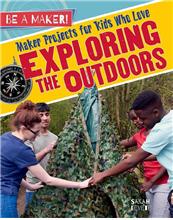 |
Maker Projects for Kids Who Love Exploring the Outdoors. (Be a Maker!).
Sarah Levete.
St. Catharines, ON: Crabtree, 2017.
32 pp., pbk., hc., & html, $9.95 (pbk.), $21.56 (RLB).
ISBN 978-0-7787-2582-4 (pbk.), ISBN 978-0-7787-2576-3 (RLB), ISBN 978-1-4271-1764-9 (html).
Subject Headings:
Nature craft-Juvenile literature.
Handicraft-Juvenile literature.
Grades 5-7 / Ages 10-12.
Review by Gail Hamilton.
** /4
|
| |
|
 |
Maker Projects for Kids Who Love Paper Engineering. (Be a Maker!).
Rebecca Sjonger.
St. Catharines, ON: Crabtree, 2017.
32 pp., pbk., hc., & html, $9.95 (pbk.), $21.56 (RLB).
ISBN 978-0-7787-2583-1 (pbk.), ISBN 978-0-7787-2577-0 (RLB), ISBN 978-1-4271-1765-6 (html).
Subject Headings:
Paper work-Juvenile literature.
Handicraft-Juvenile literature.
Grades 5-7 / Ages 10-12.
Review by Gail Hamilton.
** /4
|
| |
|
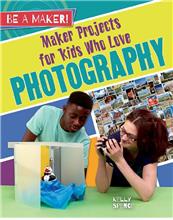 |
Maker Projects for Kids Who Love Photography. (Be a Maker!).
Kelly Spence.
St. Catharines, ON: Crabtree, 2017.
32 pp., pbk., hc., & html, $9.95 (pbk.), $21.56 (RLB).
ISBN 978-0-7787-2584-8 (pbk.), ISBN 978-0-7787-2578-7 (RLB), ISBN 978-1-4271-1766-3 (html).
Subject Headings:
Photography-Juvenile literature.
Cameras-Juvenile literature.
Grades 5-7 / Ages 10-12.
Review by Gail Hamilton.
** /4
|
| |
|
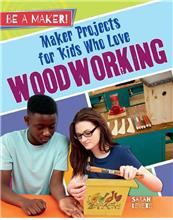 |
Maker Projects for Kids Who Love Woodworking. (Be a Maker!).
Sarah Levete.
St. Catharines, ON: Crabtree, 2017.
32 pp., pbk., hc., & html, $9.95 (pbk.), $21.56 (RLB).
ISBN 978-0-7787-2585-5 (pbk.), ISBN 978-0-7787-2579-4 (RLB), ISBN 978-1-4271-1767-0 (html).
Subject Headings:
Woodwork-Juvenile literature.
Handicraft-Juvenile literature.
Grades 5-7 / Ages 10-12.
Review by Gail Hamilton.
** /4
|
| |
|

excerpt:
Diagrams of electronic circuits show the arrangement of components they contain. The power source is normally a battery for simple circuits. It is shown with two parallel lines, one longer than the other. The longer line has a plus sign for the positive terminal of the battery. The shorter line has a negative sign for the negative terminal. The voltage is sometimes shown, as well, for example, 6 V. The straight lines in the diagram represent the wire connecting each part of the circuit. The zigzag or wavy symbol represents a resistor. Variable resistors have the addition of an arrow pointing down to the resistor. Capacitators are drawn using two parallel lines. For some types of capacitators, a plus sign will be added near one line to show how to connect the capacitator in the circuit. (From Maker Projects for Kids Who Love Electronics.)
The Maker Movement is a growing community of inventors, designers and tinkerers employing Do-It-Yourself (DIY) and Do-It-With-Others (DIWO) techniques and processes to create new products. These products usually fall within, but are not restricted to, the categories of Science, Technology, Engineering, Arts and Mathematics (STEAM). The use of upcycled materials is encouraged. "Makers", whose attributes include creativity, problem-solving and critical-thinking skills, imagination, innovation, inventiveness and risk-taking, work in their homes, garages and workshops which are referred to as "makerspaces". Failure is considered an opportunity for learning. Maker Fairs are held all around the world. They are family-oriented festivals which celebrate the Maker Movement and allow participants to share what they have created and learned.
The "Be a Maker!" series, now numbering 12 titles, not only encourages readers to follow their passion but also to collaborate with other similar-minded individuals to develop new ideas. Each title focuses on a particular area of interest and includes some history of the field, information about the various techniques used, tips and suggestions, and "Makers and Shakers" text boxes which feature past and current innovators. "Be a Maker!" sidebars pose critical-thinking questions designed to extend the reader's understanding of the topic. In addition, there are three projects for readers to try (as such, the titles of the books are misleading because the books are not merely comprised of projects). Bright and colourful, the books have an attractive layout with the text printed in geometric-shaped boxes. The covers, with photos of junior high school age teens, support the publisher’s suggested target audience range, but the books’ large size, their layout and the large print are too juvenile, and so it is unlikely that young teens will find the books appealing enough to borrow or purchase. Perhaps the strongest criticism of the series is that the books are too inconsistent in terms of complexity of projects, vocabulary and comprehension level. Illustrations consist of diagrams and photographs, well-suited to the text. A table of contents, a glossary and an index are included, and a "Learning More" section provides a brief list of books and web sites to support further research.
Maker Projects for Kids Who Love Designing Spaces introduces readers to the elements of design - colour, form, line, pattern and texture - and explains how harmony, rhythm, emphasis (focal point), scale, balance and function combine to create an appealing space. Readers can make an idea board with photos and fabric swatches and a three-dimensional model of their bedroom. A project suitable for older students is refinishing a wooden table, but it requires parental supervision for safety reasons, and the cost of materials could be a deterrent.
In Maker Projects for Kids Who Love Electronics, readers will learn about the difference between electronic and electrical devices (somewhat confusing for the target audience), series versus parallel circuits, circuit boards and LEDs. Projects include instructions for how to make a squishy circuit out of a battery pack, snap connector, play dough and LEDs; an electronic circuit using a small solderless breadboard (circuit platform); and a three-penny radio. These projects would definitely involve a trip to an electronics or hardware store. In this title, there is just too much information for the reader and no real explanation of how all of the electrical parts work together, and the instructions for the electronic circuit project lack clarity.
One of the goals of Maker Projects for Kids Who Love Exploring the Outdoors is for kids to gain an appreciation of nature. This book covers a lot of ground, from geo-caching, bug-watching and biomimicry, to insects, plants and the night sky. Though this title contains a lot of ideas, it is too vague in some areas, requiring a great deal of research and initiative on the part of the reader, one example being a suggestion that kids could create a community pollinator patch to attract bees. Readers are encouraged to go on nature hikes in groups, keeping safety issues in mind (this activity is definitely not for the lower end of the target audience who would likely need an adult to accompany them), being careful not to touch plants that they cannot identify (more research needed on the part of the reader), and avoiding animals. Projects include building a bug house, a shelter for people, and a sundial. The first two projects can be a bit pricey as they require lumber or garden stakes, camouflage netting and tarps, and the bug house requires the use of a saw.
Maker Projects for Kids Who Love Paper Engineering discusses the properties and kinds of paper as well as the ways in which paper can be folded, cut, rolled and layered to form interesting designs and unique objects. From its use in origami and tunnel books to pop-up books and 3-D objects, paper is an extremely versatile material. This title also shows photos of some three-dimensional objects made from paper- a papier maché rhinoceros, an arched bridge and a model- a building with a car ramp- with movable parts. Projects include a paper tunnel book, a pop-up greeting card and a cube storage system that consists of nine compartments. This title misses its mark for a couple of reasons: it is overly juvenile in terms of projects for the target age group, and the selection of paper engineering examples from around the world is poor. There are far better examples of remarkable and imaginative feats of paper engineering available.
Maker Projects for Kids Who Love Photography begins with a brief history of photography, from film to digital, and explains how a camera works. There is also some information about photographic accessories, such as a tripod, diffuser, and lenses and filters for special effects. Unfortunately, the text does not provide enough detailed information on how to take different types of photos (portraits, macro or close-up, action shots and landscapes), what makes a good photograph, and how to save and edit photos (JPEGs, TIFFs and RAW files). In fact, these areas are rather flimsy. By contrast, there is far more detail provided on these topics and more in Crabtree’s Get Into Photography, which is written for a much younger audience. The list of projects includes making a pinhole viewer, making a portable light tent for diffusing lights when taking macro shots, and using green screen photography. This last project requires a green screen app or photo-editing program, though no specific examples are given.
Topics in Maker Projects for Kids Who Love Woodworking include the characteristics of wood, how trees are felled, how logs are transported, processed and sorted for fuel and construction or for paper production. Environmental issues, such as illegal logging and sustainable forests, are also covered. There is so much “filler” in this title that there is not much room left for explaining actual projects. Readers will need to heed the safety rules provided and should work on the projects under an adult’s supervision since the projects require the use of different types of saws. One of the projects, a popsicle stick box with a lid, is rather juvenile for the target audience while the others, a directional sign and a birdhouse, are rather boring. Students this age will likely have far more interesting assignments in their industrial arts classes.
Though this series has potential, in its current form, it is not worthy of purchase.
Recommended with Reservations.
Gail Hamilton is a former teacher-librarian in Winnipeg, MB.

To comment
on this title or this review, send mail to cm@umanitoba.ca.
Copyright © the Manitoba Library Association. Reproduction for personal
use is permitted only if this copyright notice is maintained. Any
other reproduction is prohibited without permission.
Next Review | Table of Contents For This Issue - May 26, 2017
CM Home | Back Issues
| Search
| CM Archive
| Profiles Archive
|





